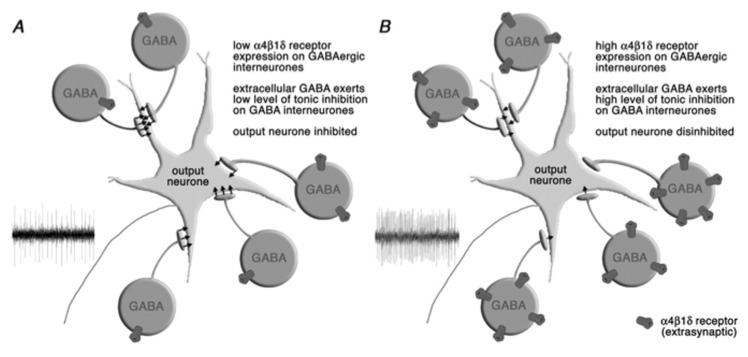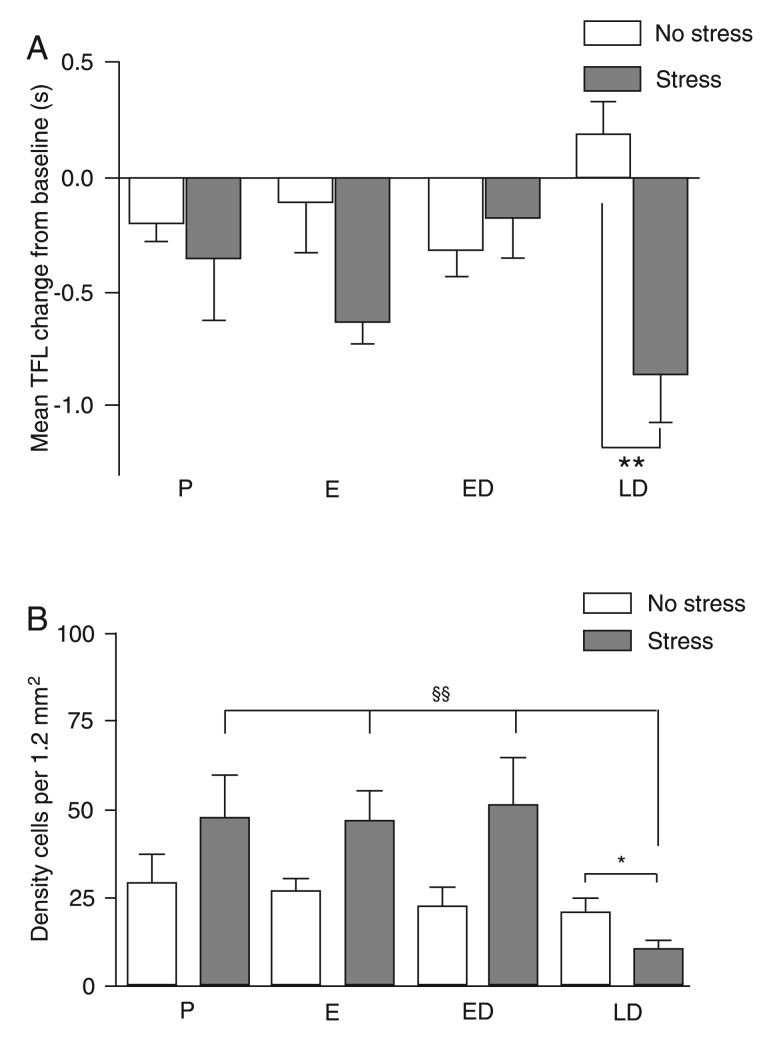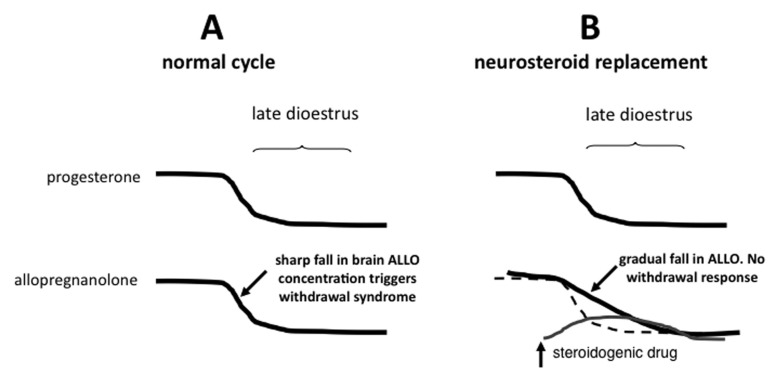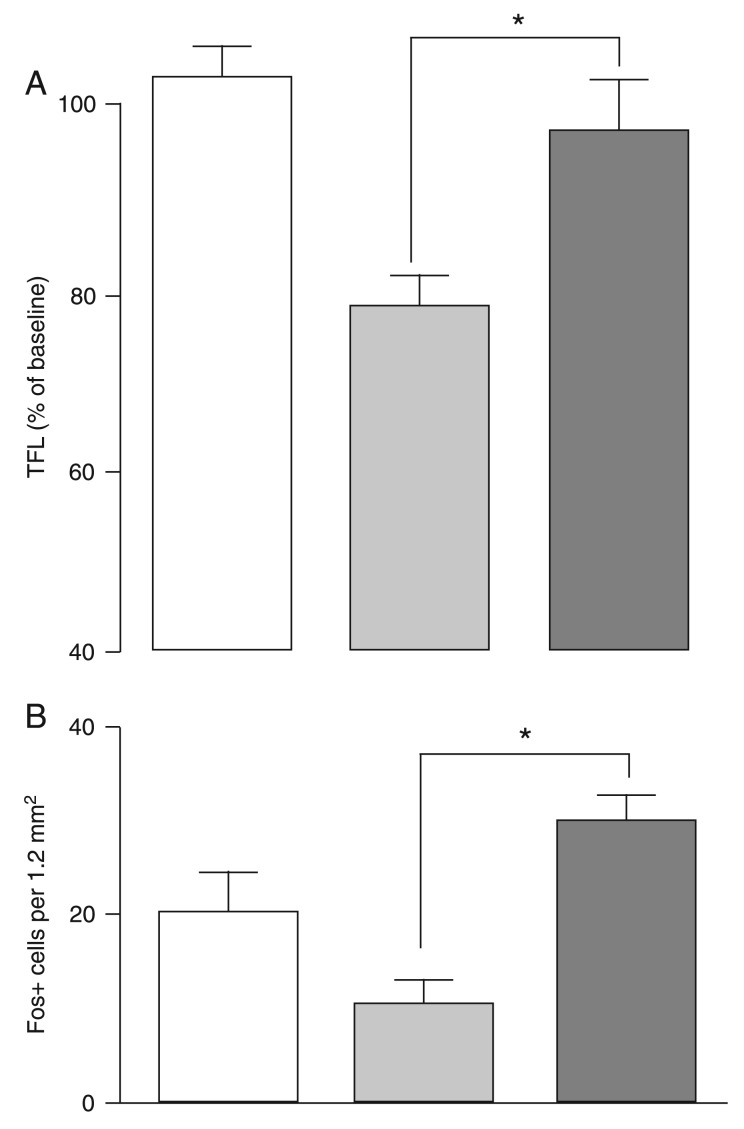Abstract
The female brain operates in a constantly changing chemical milieu caused by cyclical changes in gonadal hormones during the estrous cycle (menstrual cycle in women). Such hormones are highly lipophilic and pass readily from the plasma to the brain where they can influence neuronal function. It is becoming clear that the rapid reduction in peripheral circulating progesterone, which occurs during the late diestrous phase of the cycle, can trigger a withdrawal-like response, in which changes in GABAA receptor expression render hyper-responsive certain brain areas involved in processing responses to stressful stimuli. The periaqueductal gray matter (PAG) is recognised as an important region for integrating anxiety/defence responses. Withdrawal from progesterone, via actions of its neuroactive metabolite allopregnanolone, triggers up-regulation of extrasynaptic GABAA receptors on GABAergic neurons in the PAG. As a consequence, ongoing GABAergic tone on the output cells decreases, leading to an increase in functional excitability of the circuitry and enhanced responsiveness to stressful stimuli during the late diestrous phase. These changes during late diestrus could be prevented by short-term neurosteroid administration, timed to produce a more gradual fall in the peripheral concentration of allopregnanolone than the rapid decrease that occurs naturally, thus removing the trigger for the central withdrawal response.
Keywords: Female, Estrous cycle, Stress, Anxiety, Progesterone, Neurosteroid replacement
Responsiveness to psychological stress in females
Adverse responsiveness to psychological stress is a major health hazard, which is more prevalent in women than in men (1). The female brain, unlike its male counterpart, operates in a changing chemical milieu caused by cyclical changes in production of female sex hormones in the periphery during the menstrual cycle (estrous cycle in animals). Many of these compounds are neuroactive and their lipophilic nature enables them to pass readily through the blood brain barrier and produce significant influences on brain function through actions at both membrane-bound and nuclear receptors (2). In large numbers of women, the late luteal phase of the menstrual cycle is characterised by the development of premenstrual syndrome (PMS): a constellation of adverse psychological symptoms that include worsening of mood and episodes of aggressive behaviour, often triggered by relatively minor stressors related to everyday life (3). PMS and its more severe counterpart premenstrual dysphoric disorder (PMDD) interferes significantly with the woman's quality of life, impairing work, family relationships and other social activities. Interestingly, PMS does not occur in anovulatory cycles (4,5), suggesting that cyclical changes in sex hormones, rather than absolute levels may be the trigger for the syndrome. The late luteal phase of the menstrual cycle is characterised by a rapid decline in secretion of the sex hormones progesterone and estrogen, suggesting that one or both of these hormones may be linked to the development of symptoms. This article will focus on the recent evidence obtained in rodents that indicates that the fall in progesterone secretion, which occurs during the late diestrous phase in rats, leads to a change in gamma-aminobutyric acid (GABAA) receptor expression in the brain that is manifested behaviourally as enhanced responsiveness of the animal to mild anxiogenic stress. A consideration of the effect of estrogen on brain function and behaviour is beyond the scope of this article and has recently been reviewed elsewhere (6).
Responsiveness to stress varies during the estrous cycle in rodents
Female rodents, like women, show estrous cycle-linked changes in responsiveness to stressful situations. In general, higher levels of anxiety and responsiveness to mild anxiogenic stress have been reported in the non-receptive phase of the cycle (diestrus) compared to the receptive phase (proestrus and estrus) in both rats and mice (7-13, but see Ref. 14 for an opposite view). Unlike women in whom the late luteal (premenstrual) phase is characterised by falling levels of both estrogen and progesterone, the latter part of diestrus in rats, when responsiveness to stress is increased, is associated with a rapid fall only in plasma concentration of progesterone, whilst estrogen secretion remains at a stable low level (15). Since progesterone passes the blood brain barrier readily, fluctuations in peripheral secretion will be reflected in the brain. Falling concentration of progesterone in the brain could therefore be the key factor that triggers increased responsiveness to acute stress during late diestrus in rats and, by analogy, during the late luteal phase in women. In support of this idea, behavioural changes similar to those seen in late diestrus can be induced in rats by withdrawal from longterm dosing with exogenous progesterone (16-19). The behaviour of spontaneously cycling rats in late diestrus therefore appears to offer a useful model in which to study the role of progesterone in the development of premenstrual syndrome in women.
Falling progesterone leads to changes in neuronal excitability
There are several indications that rapid fluctuations in endogenous steroid concentrations result in altered GABAA receptor kinetics, which impacts on neuronal excitability. In rats, withdrawal from progesterone, either during the late diestrus phase in cycling animals or following an exogenous progesterone withdrawal dosing regimen, has been shown to evoke up-regulation of α4, β1 and δ subunits of the GABAA receptor in several brain structures (7,19-23). The effect was due not to progesterone itself but to the fall in concentration of its neuroactive metabolite allopregnanolone (ALLO), which triggers enhanced transcription of the genes encoding α4, β1 and δ subunits of the GABAA receptor (16,17,23). Alpha4, β1 and δ subunits are able to assemble into functional receptors. Recombinant α4β1δ GABAA receptors show electrophysiological properties characteristic of other extrasynaptic receptors containing δ subunits. Typically, these act tonically to modify the level of ongoing GABAergic inhibitory activity that regulates the excitability of neuronal ensembles (22,24-26).
Functional consequences of progesterone withdrawal
There is now compelling evidence that a reduction in brain concentration of progesterone enhances stress-induced anxiety-linked behaviours. Whether induced experimentally by withdrawal from an exogenous progesterone dosing regimen (17,22,23,27,28) or occurring naturally as a response to natural fluctuations during the estrous cycle (10-12,18), falling progesterone is anxiogenic in a variety of behavioural tests.
The periaqueductal gray matter (PAG) is a midbrain region recognised as key to mediating behavioural and autonomic components of responses to stressful challenge. As such, it has the potential to provide a useful brain locus for investigating the mechanisms underlying female hormone-induced links between transcriptional changes at the receptor level and changes in neuronal excitability and behaviour. As with other brain regions, the vast majority of studies on this region have been carried out in males. However, as the results from more studies on females begin to emerge, it is becoming clear not only that the PAG is involved in processing stress-evoked behaviour in the female sex, as in males, but also that the excitability of its circuitry fluctuates during the estrous cycle. In females in late diestrus, the fall in brain concentration of progesterone, and hence ALLO, that occurs during this stage, triggers up-regulation of extrasynaptic α4βδ GABAA receptor expression in the PAG, which is confined principally to the GABAergic neuronal subpopulation (Figure 1). This transcriptional change correlates with an increase in functional excitability of the intrinsic PAG circuitry that translates in the conscious animal to raised anxiety levels and increased behavioural responsiveness to acute psychogenic stress (Figure 2A). At the cellular level electrophysiological studies in spontaneously cycling rats in vivo have demonstrated that GABAergic tone on output neurons within the PAG is reduced during the late diestrous phase (29), which renders the circuitry intrinsically more excitable. Direct evidence for an increase in functional excitability of the PAG circuitry during late diestrus has been provided by the recent report of a lowered threshold for escape behaviour evoked by direct electrical stimulation in the PAG in late diestrus (30). Autonomic responsiveness to a pentagastrin, a panicogenic agent known to activate PAG circuitry following systemic administration, was also increased during the late diestrous phase (31). At this time, functional activation of PAG circuitry evoked by acute exposure to a mild anxiogenic stress is also changed, as reflected by decreased regional expression of the immediate early gene c-fos (32 and Figure 2B). At the present time the phenotype of the Fos-positive population in the PAG has not been determined. However, the findings are consistent with a stress-induced decreased c-fos expression in the GABAergic population, and at the same time with an increase in c-fos expression in PAG output neurons, which are likely to be less numerous than the GABAergic population.
Figure 1. Schematic drawing showing the functional consequences of increased α4β1δ GABAA receptor expression in the periaqueductal gray matter (PAG). A, When expression of α4β1δ receptors is low, spontaneous activity in GABAergic interneurones in the PAG limits the excitability of the output neurones. B, Increased expression of α4β1δ receptors when progesterone levels fall in late diestrous leads to an increase in tonic current carried by GABAergic cells, which limits their ongoing activity. The output neurones therefore become intrinsically more excitable, and the threshold for activation by stressful stimuli is lowered. Reproduced from Ref. 41 with permission.
Figure 2. A, Change in latency of the tail flick reflex (s) following exposure to 5-min anxiogenic vibration stress in rats at different stages of the estrous cycle. Data (mean ± SEM) are reported as change in tail flick latency (TFL) from baseline in 6-min post-vibration stress. B, Density of Fos-positive neurons in the periaqueductal gray matter (PAG) of rats exposed to anxiogenic stress and tail flick testing at different stages of the estrous cycle. P = proestrus; E = estrus; ED = early diestrus; LD = late diestrus. Figure drawn from data in Ref. 32 and reproduced with permission. *P < 0.05, **P < 0.01 (post hoc Bonferroni test) stressed group compared to the non-stressed group after significant (P < 0.05) one-way ANOVA. §§P < 0.01 LD stressed group compared to stressed rats at all other stages of the estrous cycle (post hoc Bonferroni test).
Interestingly, in hippocampal tissue withdrawal from progesterone evoked an increased α4 receptor expression in the hippocampus and a reduction in total GABA-stimulated current measured in dissociated pyramidal neurons (17,33). No effects were observed in cortex or cerebellum. Thus, there may be regional differences with respect to the effects triggered by withdrawal from progesterone. Moreover, at the cellular level the functional outcome of receptor upregulation appears to be dependent on the cell type that expresses α4 subunit-containing GABAA receptors, e.g., interneurons or principal neurons.
The kinetics of progesterone withdrawal determines its anxiogenic effect
It is becoming clear that withdrawal from progesterone during the late diestrous phase induces a rebound hyperexcitable state manifested by significant changes in responsiveness to anxiogenic stress. Interestingly, the critical event for inducing this effect may be related to the kinetics of the decline in steroid levels rather than the absolute magnitude of the fall. In a study on female rats chronically treated with estrogen and progesterone, a rapid withdrawal of these hormones precipitated increased startle and anxiety-like behaviour, which was not seen if the hormone levels were allowed to decline gradually (34,35). Since similar increases in anxiety behaviour can be precipitated by abrupt withdrawal from progesterone alone (16-18), the trigger for anxiogenesis in the former study is likely to be the rapid decline in concentration in the brain of progesterone, and hence its neuroactive metabolite ALLO. Measures to produce a more gradually tapered fall in progesterone levels might therefore be effective in preventing the withdrawal effect.
Neurosteroid replacement in late diestrus prevents the development of stress-induced hyperalgesia
We hypothesized that short-term neurosteroid replacement, timed to blunt the rate of the natural fall in ALLO that occurs during the late diestrous phase in spontaneously cycling rats, should prevent the increased responsiveness to stress that normally occurs at this time (Figure 3). In males the selective serotonin reuptake inhibitor (SSRI) fluoxetine has been shown to produce rapid onset steroidogenic effects following acute administration, by raising plasma and brain concentrations of ALLO (36-38). Importantly, these effects could be induced at doses below the threshold for effects on 5-hydroxytryptamine (5-HT) systems (37). We have shown that short-term administration of a low dose of fluoxetine (1.75 mg/kg, ip) was also steroidogenic in females, producing a doubling of whole brain ALLO concentration (39).
Figure 3. Schematic presentation of the rationale behind short-term neurosteroid replacement to prevent development of progesterone withdrawal-evoked anxiogenesis during late diestrus. A, At late diestrus, the fall in brain concentration of progesterone and its neuroactive metabolite allopregnanolone (ALLO) triggers a withdrawal syndrome manifested as an increased responsiveness to stress. B, Short-term dosing with a steroidogenic agent in the evening of early diestrus should raise plasma and hence brain allopregnanolone transiently and so blunt the rapid fall in allopregnanolone that normally occurs during late diestrus. The trigger for development of the withdrawal syndrome should be removed.
Compared to other cycle stages, rats in late diestrus normally show an exaggerated response to anxiogenic vibration stress, which is manifested as hyperalgesia (18). Administering low-dose fluoxetine to female rats on the evening of early diestrus, with a top up next morning when they had reached late diestrus, completely prevented the development of stress-induced hyperalgesia (Figure 4A). Similarly, the functional deactivation within the PAG that is normally induced by exposure to the vibration stress in late diestrus was prevented as well (Figure 4B). Importantly, the behavioural effects of fluoxetine could be reproduced following dosing with ganaxolone (data not shown), a synthetic analogue of ALLO not reported to have effects on 5-HT systems (40). Thus, the effect of fluoxetine is likely to be due to its steroidogenic action. The dramatic effects of short-term neurosteroid replacement in preventing the appearance of estrous cycle-linked anxiogenesis in rats may have relevance to the quest for more effective treatments of menstrual cycle-linked dysphoria in women.
Figure 4. A, Short-term dosing with fluoxetine (1.75 mg/kg) on the evening of late diestrus, with a top up on the morning of late diestrus, prevents the development of stress-induced hyperalgesia during late diestrus (decrease in tail flick latency (TFL) compared to naive non-stressed rats). White bars = non-stressed rats; light gray bars = stressed vehicle-treated rats; dark gray bars = stressed fluoxetine-treated rats. B, Fluoxetine administration also prevented the reduction in stress-induced functional deactivation in the periaqueductal gray matter (PAG) (decrease in density of Fos-positive neurons in the PAG compared to naive non-stressed rats; Devall AJ and Lovick TA, unpublished results). *P < 0.05 compared to vehicle-treated rats in late diestrus (oneway ANOVA followed by the Bonferroni test).
In conclusion, the data summarized here show how cyclical changes in production of progesterone during the estrous cycle can have a powerful effect on functioning of the female brain. In rodents, this occurs over a remarkably short time frame. The withdrawal effects evoked by the natural cyclical variation in secretion of progesterone during the estrous cycle occur over 12- to 24-h periods, influencing anxiety levels and responsiveness to anxiogenic stress. To date the overwhelming majority of the studies on brain function and behaviour in animals has been confined to males, a common argument for the single sex approach being that data obtained from females are more variable and may be confounded by hormonal influences. Increasingly, however, it is being recognized that sex differences do exist, both in terms of behaviour and responsiveness to certain drugs. It is essential that the effects of possible influences of the ovarian cycle on brain function and behaviour are incorporated into experimental designs in future studies using females. In a world in which 50% of the population is female, such differences are important and should no longer be overlooked.
References
- 1.Legato MJ. The skewed sex distribution in affective disorders - a diagnostic, social, or biological problem? Prog Brain Res. 2010;186:159–166. doi: 10.1016/B978-0-444-53630-3.00010-5. [DOI] [PubMed] [Google Scholar]
- 2.Paul SM, Purdy RH. Neuroactive steroids. FASEB J. 1992;6:2311–2322. [PubMed] [Google Scholar]
- 3.O'Brien S, Rapkin A, Dennerstein L, Nevatte T. Diagnosis and management of premenstrual disorders. BMJ. 2011;342:d2994. doi: 10.1136/bmj.d2994. [DOI] [PubMed] [Google Scholar]
- 4.Backstrom T, Andreen L, Birzniece V, Bjorn I, Johansson IM, Nordenstam-Haghjo M, et al. The role of hormones and hormonal treatments in premenstrual syndrome. CNS Drugs. 2003;17:325–342. doi: 10.2165/00023210-200317050-00003. [DOI] [PubMed] [Google Scholar]
- 5.Hammarback S, Ekholm UB, Backstrom T. Spontaneous anovulation causing disappearance of cyclical symptoms in women with the premenstrual syndrome. Acta Endocrinol. 1991;125:132–137. doi: 10.1530/acta.0.1250132. [DOI] [PubMed] [Google Scholar]
- 6.Handa RJ, Ogawa S, Wang JM, Herbison AE. Roles for oestrogen receptor beta in adult brain function. J Neuroendocrinol. 2012;24:160–173. doi: 10.1111/j.1365-2826.2011.02206.x. [DOI] [PMC free article] [PubMed] [Google Scholar]
- 7.Gangitano D, Salas R, Teng Y, Perez E, De Biasi M. Progesterone modulation of alpha5 nAChR subunits influences anxiety-related behavior during estrus cycle. Genes Brain Behav. 2009;8:398–406. doi: 10.1111/j.1601-183X.2009.00476.x. [DOI] [PMC free article] [PubMed] [Google Scholar]
- 8.Gouveia A, Jr, dos Santos UD, Felisbino FE, de Afonseca TL, Antunes G, Morato S. Influence of the estrous cycle on the behavior of rats in the elevated T-maze. Behav Processes. 2004;67:167–171. doi: 10.1016/j.beproc.2004.03.018. [DOI] [PubMed] [Google Scholar]
- 9.Ho HP, Olsson M, Westberg L, Melke J, Eriksson E. The serotonin reuptake inhibitor fluoxetine reduces sex steroid-related aggression in female rats: an animal model of premenstrual irritability? Neuropsychopharmacology. 2001;24:502–510. doi: 10.1016/S0893-133X(00)00219-0. [DOI] [PubMed] [Google Scholar]
- 10.Koonce CJ, Walf AA, Frye CA. Type 1 5alpha-reductase may be required for estrous cycle changes in affective behaviors of female mice. Behav Brain Res. 2012;226:376–380. doi: 10.1016/j.bbr.2011.09.028. [DOI] [PMC free article] [PubMed] [Google Scholar]
- 11.Marcondes FK, Miguel KJ, Melo LL, Spadari-Bratfisch RC. Estrous cycle influences the response of female rats in the elevated plus-maze test. Physiol Behav. 2001;74:435–440. doi: 10.1016/s0031-9384(01)00593-5. [DOI] [PubMed] [Google Scholar]
- 12.Mora S, Dussaubat N, Diaz-Veliz G. Effects of the estrous cycle and ovarian hormones on behavioral indices of anxiety in female rats. Psychoneuroendocrinology. 1996;21:609–620. doi: 10.1016/s0306-4530(96)00015-7. [DOI] [PubMed] [Google Scholar]
- 13.Reddy DS, Kulkarni SK. Sex and estrous cycle-dependent changes in neurosteroid and benzodiazepine effects on food consumption and plus-maze learning behaviors in rats. Pharmacol Biochem Behav. 1999;62:53–60. doi: 10.1016/s0091-3057(98)00126-9. [DOI] [PubMed] [Google Scholar]
- 14.Hiroi R, Neumaier JF. Differential effects of ovarian steroids on anxiety versus fear as measured by open field test and fear-potentiated startle. Behav Brain Res. 2006;166:93–100. doi: 10.1016/j.bbr.2005.07.021. [DOI] [PubMed] [Google Scholar]
- 15.Butcher RL, Collins WE, Fugo NW. Plasma concentration of LH, FSH, prolactin, progesterone and estradiol-17beta throughout the 4-day estrous cycle of the rat. Endocrinology. 1974;94:1704–1708. doi: 10.1210/endo-94-6-1704. [DOI] [PubMed] [Google Scholar]
- 16.Smith SS, Gong QH, Hsu FC, Markowitz RS, ffrench-Mullen JM, Li X. GABA(A) receptor alpha4 subunit suppression prevents withdrawal properties of an endogenous steroid. Nature. 1998;392:926–930. doi: 10.1038/31948. [DOI] [PubMed] [Google Scholar]
- 17.Smith SS, Gong QH, Li X, Moran MH, Bitran D, Frye CA, et al. Withdrawal from 3alpha-OH-5alpha-pregnan-20-One using a pseudopregnancy model alters the kinetics of hippocampal GABAA-gated current and increases the GABAA receptor alpha4 subunit in association with increased anxiety. J Neurosci. 1998;18:5275–5284. doi: 10.1523/JNEUROSCI.18-14-05275.1998. [DOI] [PMC free article] [PubMed] [Google Scholar]
- 18.Devall AJ, Liu ZW, Lovick TA. Hyperalgesia in the setting of anxiety: sex differences and effects of the oestrous cycle in Wistar rats. Psychoneuroendocrinology. 2009;34:587–596. doi: 10.1016/j.psyneuen.2008.10.021. [DOI] [PubMed] [Google Scholar]
- 19.Gangisetty O, Reddy DS. Neurosteroid withdrawal regulates GABA-A receptor alpha4-subunit expression and seizure susceptibility by activation of progesterone receptor-inde-pendent early growth response factor-3 pathway. Neuroscience. 2010;170:865–880. doi: 10.1016/j.neuroscience.2010.07.037. [DOI] [PMC free article] [PubMed] [Google Scholar]
- 20.Griffiths J, Lovick T. Withdrawal from progesterone increases expression of alpha4, beta1, and delta GABA(A) receptor subunits in neurons in the periaqueductal gray matter in female Wistar rats. J Comp Neurol. 2005;486:89–97. doi: 10.1002/cne.20540. [DOI] [PubMed] [Google Scholar]
- 21.Griffiths JL, Lovick TA. GABAergic neurones in the rat periaqueductal grey matter express alpha4, beta1 and delta GABAA receptor subunits: plasticity of expression during the estrous cycle. Neuroscience. 2005;136:457–466. doi: 10.1016/j.neuroscience.2005.08.013. [DOI] [PubMed] [Google Scholar]
- 22.Lovick TA, Griffiths JL, Dunn SM, Martin IL. Changes in GABA(A) receptor subunit expression in the midbrain during the oestrous cycle in Wistar rats. Neuroscience. 2005;131:397–405. doi: 10.1016/j.neuroscience.2004.11.010. [DOI] [PubMed] [Google Scholar]
- 23.Gulinello M, Orman R, Smith SS. Sex differences in anxiety, sensorimotor gating and expression of the alpha4 subunit of the GABAA receptor in the amygdala after progesterone withdrawal. Eur J Neurosci. 2003;17:641–648. doi: 10.1046/j.1460-9568.2003.02479.x. [DOI] [PMC free article] [PubMed] [Google Scholar]
- 24.Mody I. Aspects of the homeostatic plasticity of GABAA receptor-mediated inhibition. J Physiol. 2005;562:37–46. doi: 10.1113/jphysiol.2004.077362. [DOI] [PMC free article] [PubMed] [Google Scholar]
- 25.Smith SS, Gong QH. Neurosteroid administration and withdrawal alter GABAA receptor kinetics in CA1 hippocampus of female rats. J Physiol. 2005;564:421–436. doi: 10.1113/jphysiol.2004.077297. [DOI] [PMC free article] [PubMed] [Google Scholar]
- 26.Wei W, Zhang N, Peng Z, Houser CR, Mody I. Perisynaptic localization of delta subunit-containing GABA(A) receptors and their activation by GABA spillover in the mouse dentate gyrus. J Neurosci. 2003;23:10650–10661. doi: 10.1523/JNEUROSCI.23-33-10650.2003. [DOI] [PMC free article] [PubMed] [Google Scholar]
- 27.Gallo MA, Smith SS. Progesterone withdrawal decreases latency to and increases duration of electrified prod burial: a possible rat model of PMS anxiety. Pharmacol Biochem Behav. 1993;46:897–904. doi: 10.1016/0091-3057(93)90219-j. [DOI] [PubMed] [Google Scholar]
- 28.Lofgren M, Johansson IM, Meyerson B, Lundgren P, Backstrom T. Progesterone withdrawal effects in the open field test can be predicted by elevated plus maze performance. Horm Behav. 2006;50:208–215. doi: 10.1016/j.yhbeh.2006.03.002. [DOI] [PubMed] [Google Scholar]
- 29.Brack KE, Lovick TA. Neuronal excitability in the periaqueductal grey matter during the estrous cycle in female Wistar rats. Neuroscience. 2007;144:325–335. doi: 10.1016/j.neuroscience.2006.08.058. [DOI] [PubMed] [Google Scholar]
- 30.Santos JM, Lovick TA, Brandão ML. Effects of acute treatment with fluoxetine on the neural substrates of fear of the periaqueductal gray matter in female rats. Neuroscience. 2011:Abstract 281.02. [Google Scholar]
- 31.Brack KE, Jeffery SM, Lovick TA. Cardiovascular and respiratory responses to a panicogenic agent in anaesthetised female Wistar rats at different stages of the oestrous cycle. Eur J Neurosci. 2006;23:3309–3318. doi: 10.1111/j.1460-9568.2006.04881.x. [DOI] [PubMed] [Google Scholar]
- 32.Devall AJ, Santos JM, Lovick TA. Estrous cycle stage influences on neuronal responsiveness to repeated anxiogenic stress in female rats. Behav Brain Res. 2011;225:334–340. doi: 10.1016/j.bbr.2011.07.038. [DOI] [PubMed] [Google Scholar]
- 33.Bitran D, Smith SS. Termination of pseudopregnancy in the rat produces an anxiogenic-like response that is associated with an increase in benzodiazepine receptor binding density and a decrease in GABA-stimulated chloride influx in the hippocampus. Brain Res Bull. 2005;64:511–518. doi: 10.1016/j.brainresbull.2004.11.001. [DOI] [PubMed] [Google Scholar]
- 34.Doornbos B, Fokkema DS, Molhoek M, Tanke MA, Postema F, Korf J. Abrupt rather than gradual hormonal changes induce postpartum blues-like behavior in rats. Life Sci. 2009;84:69–74. doi: 10.1016/j.lfs.2008.10.014. [DOI] [PubMed] [Google Scholar]
- 35.Saavedra M, Contreras CM, Azamar-Arizmendi G, Hernandez-Lozano M. Differential progesterone effects on defensive burying and forced swimming tests depending upon a gradual decrease or an abrupt suppression schedules. Pharmacol Biochem Behav. 2006;83:130–135. doi: 10.1016/j.pbb.2005.12.016. [DOI] [PubMed] [Google Scholar]
- 36.Uzunov DP, Cooper TB, Costa E, Guidotti A. Fluoxetine-elicited changes in brain neurosteroid content measured by negative ion mass fragmentography. Proc Natl Acad Sci U S A. 1996;93:12599–12604. doi: 10.1073/pnas.93.22.12599. [DOI] [PMC free article] [PubMed] [Google Scholar]
- 37.Pinna G, Costa E, Guidotti A. SSRIs act as selective brain steroidogenic stimulants (SBSSs) at low doses that are inactive on 5-HT reuptake. Curr Opin Pharmacol. 2009;9:24–30. doi: 10.1016/j.coph.2008.12.006. [DOI] [PMC free article] [PubMed] [Google Scholar]
- 38.Serra M, Pisu MG, Muggironi M, Parodo V, Papi G, Sari R, et al. Opposite effects of short- versus long-term administration of fluoxetine on the concentrations of neuroactive steroids in rat plasma and brain. Psychopharmacology. 2001;158:48–54. doi: 10.1007/s002130100853. [DOI] [PubMed] [Google Scholar]
- 39.Devall A, Fry JP, Honour JW, Lovick TA. Short term, low dose fluoxetine treatment increases brain allopregnanolone concentrations in female rats and abolishes estrous cycle-related stress-induced hyperalgesia? Proc Physiol Soc. 2011;22:PC11. [Google Scholar]
- 40.Nohria V, Giller E. Ganaxolone. Neurotherapeutics. 2007;4:102–105. doi: 10.1016/j.nurt.2006.11.003. [DOI] [PMC free article] [PubMed] [Google Scholar]
- 41.Lovick TA. Plasticity of GABAA receptor subunit expression during the oestrous cycle of the rat: implications for premenstrual syndrome in women. Exp Physiol. 2006;91:655–660. doi: 10.1113/expphysiol.2005.032342. [DOI] [PubMed] [Google Scholar]






